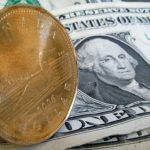Gold ticked up in early European trading on Friday but headed for its worst weekly performance in five weeks as another bit of key US data backed the case of a near-term interest rate increase by the Federal Reserve.
Comex gold for delivery in December traded 0.64% higher at $1 129.8 per troy ounce at 06:54 GMT, shifting in a daily range of $1 131.7 – $1 123.6. The contract fell 0.2% on Thursday, sliding for a fourth straight day, and is down 2.6% for the week.
The precious metal extended its decline after the Bureau of Economic Analysis revised up its second-quarter GDP estimate to 3.7%, up from an initial measure of 2.3%. This exceeded analysts projections of 3.2% growth, supporting expectations for an interest rate hike this year, with a minority of analysts still expecting the Federal Reserve to take action at its policy meeting next month.
The second-quarter GDP revision added to recent solid employment, housing and business activity data that has kept the US dollar supported and has limited golds upside momentum during the recent stock market rout. Durable goods orders expanded in July, according to a Wednesday report, defying analysts’ projections for a contraction, while earlier data had shown that sales of new homes rebounded last month and services sector activity posted solid growth in August.
The US dollar continued its recovery on Thursday, with a gauge measuring its strength versus a basket of major trading peers jumping for a third day. The US dollar index contract for settlement in September was mostly unchanged at 95.665 at 06:54 GMT today after it closed 0.6% higher on Thursday at 95.652, having earlier risen to a one-week high of 96.060.
However, some analysts worried that the strong second-quarter expansion might not be sustainable as a large part of it came from a buildup in inventories, which is usually followed by lower economic activity as inventories are drawn down. These expectations, coupled with the recent turmoil in global markets have lowered the probability of the Federal Reserve raising borrowing costs in September, but comments by US officials have led investors to believe a move in October or December is very likely. According to Bloomberg data, traders rate a 26% chance of the Fed hiking in September, down from 40% at the end of July, but are pricing in a 50% chance for action to be taken by the end of the year.
New York Fed President William Dudley said on Wednesday that a September increase looks “less compelling” given the threat posed to the US economy by recent market turmoil. Atlanta Fed President Dennis Lockhart said earlier this week that interest rates will likely receive a boost “sometime this year,” even as plummeting oil prices cloud the inflation outlook. Two weeks ago, Mr. Lockhart said he was “very disposed” to a rate hike in September.
Reflecting expectations for a hike after September, holdings in bullion-backed exchange-traded funds rose by 1.8 metric tons to 1 529.40 tons as of Thursday, the highest level since July 30, Bloomberg data showed. Assets in the SPDR Gold Trust, the biggest such ETF, rose by 1.49 tons yesterday to 682.59 tons, the highest since July 23rd. Still, holdings in the fund are about 49.5% below a peak of 1353.35 tons in December 2012.
Pivot points
According to Binary Tribune’s daily analysis, December gold’s central pivot point on the Comex stands at $1 122.7. If the contract breaks its first resistance level at $1 128.4, next barrier will be at $1 134.2. In case the second key resistance is broken, the precious metal may attempt to advance to $1 139.9.
If the contract manages to breach the S1 level at $1 116.9, it will next see support at $1 111.2. With this second key support broken, movement to the downside may extend to $1 105.4.
In weekly terms, the central pivot point is at $1 145.3. The three key resistance levels are as follows: R1 – $1 182.2, R2 – $1 204.7, R3 – $1 241.6. The three key support levels are: S1 – $1 122.8, S2 – $1 085.9, S3 – $1 063.4.





